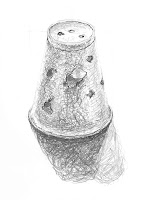Explore with 4 different rendering techniques
I will discuss four different techniques you can use to make and interesting object or to help you loosen up and think outside of the box.The first thing you can do is to create a tonal value strip on a separate piece of paper of each of these techniques. This will help you get a hang of using them and to practise going from dark to light on the tonal spectrum.
The four techniques I will be discussing are smooth, scribble, hatching and cross-hatching and pointillism. I hope that after you read this that you will find new inspiration to use these techniques in your drawings.
 |
| Smooth |
Smooth
Smooth
rendering is the most commonly used technique of rendering. You can
use the flat side of your pencil tip for smooth shading. You can vary
your pressure to achieve a wider spectrum from dark to light. Combine it with using the tip of your pencil to achieve a darker tone to add detail and texture.
 |
| Pointillism |
Pointillism
I
use pointillism when I draw with pen and ink. But is found widely
across the field of art. It can be used when painting and also with
pencil. It is the technique of using dots close to each other for
darker tones and then dots further away from each other for lighter
tones. In painting it is the art of using different colors of short
strokes next to each other and when viewed from a distance, an image
becomes clear.
 |
| Hatching & Cross-hatching |
Hatching & cross-hatching
Hatching
is the use of lines going in the same direction (directional lines).
The denser they are, the darker the tones and the further away from
each other, the lighter the tones. You can also vary the pressure of
your pencil to achieve lighter or darker tones.
Cross-hatching
is the same as hatching and it is the use vertical lines with
overlapping horizontal lines. (They are also directional, but they
cross each other)
 |
| Scribble |
Scribble
Scribble is literally scribbling like you did when you were a child. The best way to go about when scribbling is to keep you wrist relaxed. You can experiment with the angle at which you are holding your pencil to achieve a different mark as you draw. Vary the pressure at which you draw and you can overlap your scribbles to get a nice tonal spectrum in your drawing. Scribble is a great rendering technique for textured objects like the surface or a carpet or tennis ball.Some of these rendering techniques might sound strange but they work great when you want to apply texture and they are also fun to do. I recommend that you try all these techniques and most of all enjoy while you are doing it.
View page
No comments:
Post a Comment